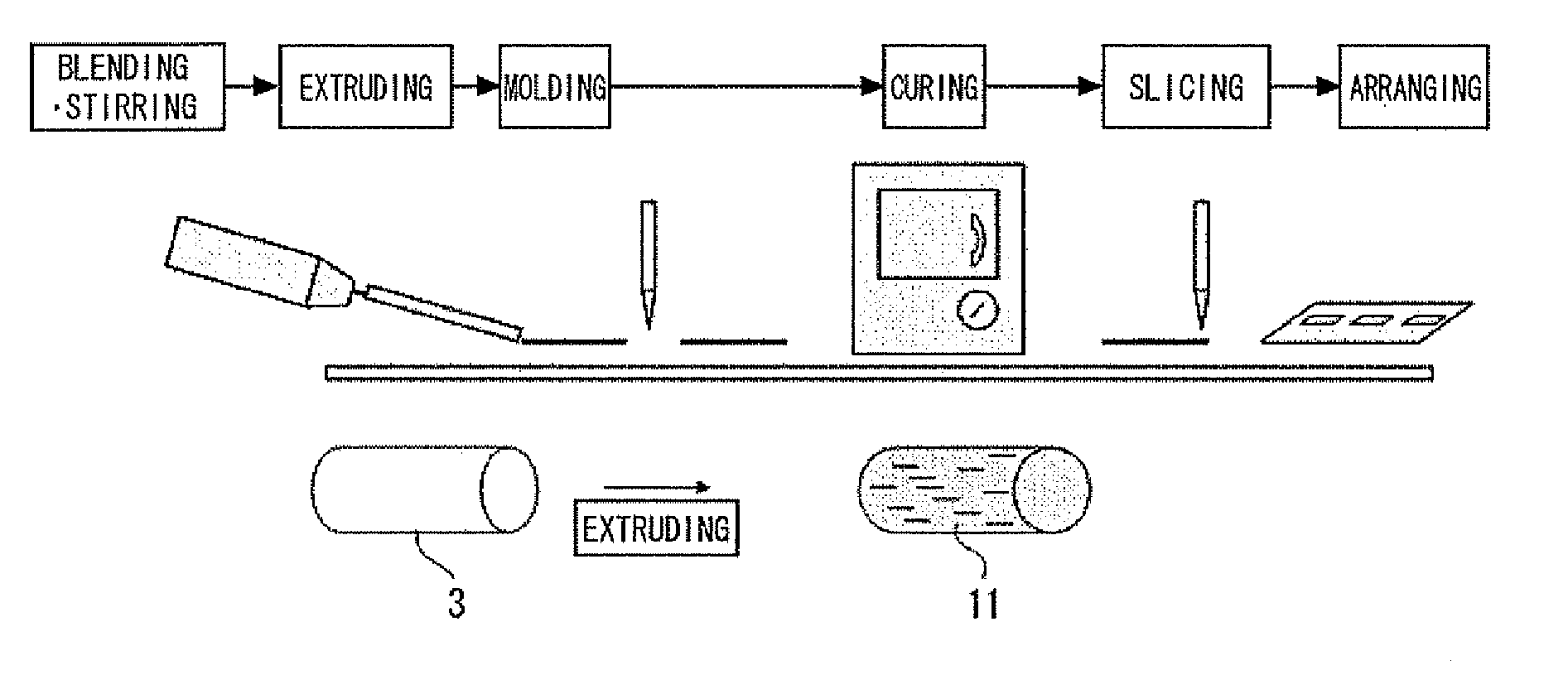Thermally conductive sheet and process for producing same
a technology of thermal conductivity and thermal insulation, which is applied in the field of thermal insulation sheets, can solve the problems of inability to effectively utilize the superior thermal conductivity the method of increasing the filling rate of the inorganic insulation layer has limitations, and the flexibility is lowered, so as to achieve low, reduce the thermal resistance, and high thermal conductivity
- Summary
- Abstract
- Description
- Claims
- Application Information
AI Technical Summary
Benefits of technology
Problems solved by technology
Method used
Image
Examples
example 1
Production of Thermally Conductive Sheet
[0106]To an addition reaction-type liquid-state silicone resin of a two-liquid type prepared by mixing 18.8% by volume of a silicone A liquid (organopolysiloxane having a vinyl group) and 18.8% by volume of a silicone B liquid (organopolysiloxane having an H—Si group) were added to be dispersed therein alumina particles (average particle size: 3 μm, Alumina DAW03, spherical shape, made by Denki Kagaku Kogyo Kabushiki Kaisha) (42.3% by volume) and pitch-based carbon fibers (average major axis length: 150 μm, average minor axis length: 8 μm, Raheama R-A301, made by Teijin Ltd.) (20.1% by volume) so that a silicone resin composition was prepared.
[0107]The resulting silicone resin composition was extrusion-molded into a mold 3 (hollow column shape) by using an extruder so that a silicone molded product was formed. A slit (extrusion outlet shape: flat plate) was formed on the extrusion outlet of the extruder.
[0108]The resulting silicone molded prod...
example 2
Production of Thermally Conductive Sheet
[0111]The same processes as those of example 1 were carried out except that in example 1, the alumina particles (average particle size: 3 μm, Alumina DAW03, spherical shape, made by Denki Kagaku Kogyo Kabushiki Kaisha) were changed to alumina particles (average particle size: 5 μm, Alumina DAW05, spherical shape, made by Denki Kagaku Kogyo Kabushiki Kaisha) so that a thermally conductive sheet of example 2 having a square shape of 15 mm in longitudinal length and 15 mm in lateral length with a thickness of 0.5 mm was formed.
example 3
Production of Thermally Conductive Sheet
[0112]The same processes as those of example 1 were carried out except that in example 1, the alumina particles (average particle size: 3 μm, Alumina DAW03, spherical shape, made by Denki Kagaku Kogyo Kabushiki Kaisha) were changed to alumina particles (average particle size: 10 μm, Alumina DAW10, spherical shape, made by Denki Kagaku Kogyo Kabushiki Kaisha) so that a thermally conductive sheet of example 3 having a square shape of 15 mm in longitudinal length and 15 mm in lateral length with a thickness of 0.5 mm was formed.
PUM
| Property | Measurement | Unit |
|---|---|---|
| Fraction | aaaaa | aaaaa |
| Angle | aaaaa | aaaaa |
| Angle | aaaaa | aaaaa |
Abstract
Description
Claims
Application Information
 Login to View More
Login to View More - R&D
- Intellectual Property
- Life Sciences
- Materials
- Tech Scout
- Unparalleled Data Quality
- Higher Quality Content
- 60% Fewer Hallucinations
Browse by: Latest US Patents, China's latest patents, Technical Efficacy Thesaurus, Application Domain, Technology Topic, Popular Technical Reports.
© 2025 PatSnap. All rights reserved.Legal|Privacy policy|Modern Slavery Act Transparency Statement|Sitemap|About US| Contact US: help@patsnap.com



